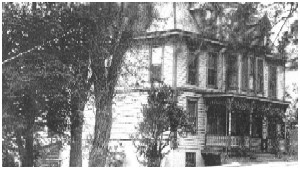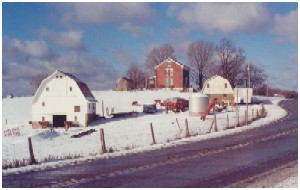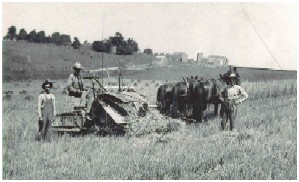
|
Flushing, Ohio -- A Brief History | ||||||||||||||||||||||||||||||||

by Bob Howell.The Village of Flushing was laid out by Jesse Foulke, 9 November 1813, and named by him. The first house was erected on the present site of the town by Reese Branson, a silversmith from St. Clairsville in the year 1809. 
Jesse Foulke taught the first school and kept the first store. The first practicing physician was Dr. Jesse Bailey. The first sermon was preached in 1818 by Michael Ellis (Methodist) at the home of Jesse Brandenburg. The town was incorporated 23 February 1849 and had a population at that time of 312. Around the early 1900s, Flushing was a "Boom Town" because the Cleveland, Lorain and Wheeling Railway entrance into the southwest end of town made the small coal mines that dotted the area into commercial ventures with the railway shipping out their coal. Some of the mines were the Old Glory Coal Mine, later called the Tunnel Mine, because of its location near the railroad tunnel (the entrance was "over the hill" from Stratton House Inn), the Massillon-Belmont Mine, the Kennon Mine and the Rosemary Mine. Laborers in the mines averaged $1.97 to $2.30 per day. Coal cars were pulled by mules. The "Society of Friends" (Quakers), established here in 1818, was at one time the strongest religious denomination in the Flushing area. The Quaker school, long since vanished, was located on Black Oak Road. The Quaker Meeting House was built in 1895 on High Street. For many years it stood empty and abandoned, and finally burned to the ground on 5 December 1959. Left now is the graveyard where so many early Quakers are buried. 
Two other cemeteries are located in Flushing. The first cemetery dating back to 1825 is located on Northwest Street. It is the resting place for people as far back as the Revolutionary War and the War of 1812. The Union Cemetery is on the corner of Markatan and High Streets. A monument at its entrance is dedicated to the Union Soldiers of the Civil War. Following are reminiscences of octogenarian, Albert Muntz, councilman for over a decade. He remembers his grandfather, Albert Cole, running a livery stable where a gasoline station subsequently was located -- across from the Catholic Church. Children would ride their horses into the village to school and leave them at his livery for the day. His parents told him about a school for African-American children which was located on High Street across from where the Warren Funeral Home is now located. A toll gate was located in front of Dr. Lose's house where Jenny Waszkiewicz now lives. Money was collected for using the limestone "pike" from Flushing to St. Clairsville. It was the only stone road in the area at the turn of the century, the rest were dirt or mud, depending on the weather. Prisoners from the County Jail were used to break up the stones and pound them into the road. For attractions in Flushing, Ohio, please see
Flushing, Ohio Attractions Captions: Top - Flushing Hospital, before it was destroyed by fire. Dr. John A Hobson, a Stratton ancestor, became associated with the hospital in 1875, and gave many years of service to the community. His sister was the wife of John Stratton, who built Stratton Mill; and the mother of George Stratton, who operated the mill for more than fifty years. Middle: The Howell Farm - on the east edge of Flushing, Ohio, welcomes you as you approach town. Note the historic brick home, which dates to the 1840s. Boattom: Working on the Howell Farm in 1910. Note the barns and house in the background. Click images for larger versions.
|
|||||||||||||||||||||||||||||||||
|
| Home |
Inn |
Mill |
Products |
Community | | History | Attractions | Contact | Site Map | Admin | |
|
|
Site: © 2002-2024 by: Pierian Press Web Services | Hosted by: Stratton House Inn Content: © 2002-2024 Stratton House Inn. All rights reserved. |